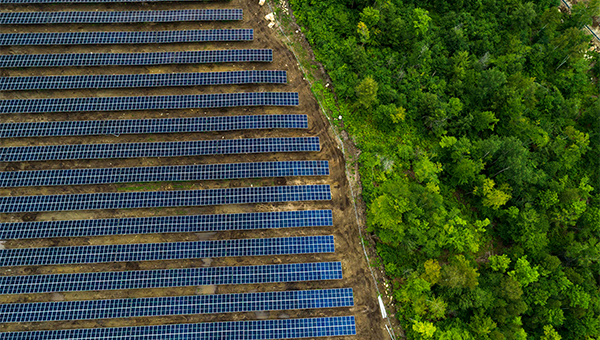With the heightened focus on sustainability, large commercial, industrial and institutional organizations are looking for ways to reduce their carbon emissions and manage climate risk. While there are many ways to lower energy consumption through efficiency measures, incorporating renewable energy in some manner is required to achieve most decarbonization or net-zero goals. Unfortunately, for most companies, transitioning to 100% renewable energy power onsite isn’t feasible due to building or land restrictions, budget constraints, or other reasons. This leaves many companies seeking alternative ways to meet 100% renewable energy goals, such as via an offsite power purchase agreement.
Offsite Power Purchase Agreements (PPAs)
Offsite renewable power purchase agreements (PPAs) do not require an organization to install solar or wind generation onsite. Offsite PPAs are an efficient way for large companies to meet renewable energy and greenhouse gas emissions reduction goals due to their scale. Most often, renewable energy facilities are built, owned and operated by the developer and the power generated from the project is delivered to the grid. Offsite PPAs transfer the renewable energy credits associated with the renewable project (RECS) to the buyer and the buyer can either have the energy from the renewable project delivered to the grid or directly to the buyer at its location.
An Offsite PPA is essentially a physical transaction, or form of contract, usually with large-scale wind and/or solar projects to purchase power and RECs. As the buyer of a PPA where the power is delivered into the grid (sometimes called a virtual PPA or vPPA by some market participants), you agree to purchase RECs at a fixed price that is adjusted based upon changes in wholesale power prices. The developer delivers the RECs to you via a registry and sells the energy into the grid at market rate. Should the developer sell the energy at a higher cost than the fixed contract price in the PPA, the developer will pass the positive difference back to you (the ‘floating market settlement’ shown in the diagram below). Conversely, however, if market rates for energy decrease in the developer’s market to below the PPA fixed price, then you may have to make a payment of the difference to the developer. By signing this contract, the project can acquire the financing needed for construction – making the buyer’s role essential for new renewable development, which is why PPAs are considered one of the most impactful ways to procure renewables.
PPAs offer many benefits:
- Can be used to cover electricity usage anywhere in the US and Canada: per the rules of sustainability reporting today, the RECs from a PPA can be used to cover reported emissions for any facilities located in the United States and Canada. This is particularly valuable for clients with many facilities located throughout the country or in regulated energy markets.
- High impact: when a PPA is signed with a new project, the buyer can make claims that they are directly responsible for bringing new renewables onto the grid, also known as “additionality.”
- Can be done at large scale: typical PPAs are around 100,000-500,000 MWh per year, making it possible for most clients to cover their entire electricity load with one or two transactions.
Example Buyer: A large retailer has warehouses and storefronts located throughout the country with a combined usage of 200,000 MWh/year. They sign a PPA in Texas and allocate the RECs across all of their locations to be 100% renewable across the US.
In an offsite physical PPA, an organization works with an energy wholesaler and/or retailer to have the energy from a large-scale wind/and or solar project physically delivered to their location. A physical PPA is offered at a fixed price for the delivered energy.
Physical PPA contracts offer many benefits:
- Steady pricing – in physical PPAs, the contract is often a fixed price for 10 to 15 years – providing energy cost certainty to the buyer.
- Reduced price volatility –the buyer in a physical PPA does not have to take on any day-to-day market volatility risk. Price risk over and above the PPA fixed price can be managed through hedging.
- A way to meet customer demand for clean energy – when the physical PPA comes with the RECs, the buyer is able to make claims that they are using renewable energy at the facilities receiving the power.
Example Buyer: An industrial company has three manufacturing plants in Northern Texas. They sign a physical PPA with a retailer to firm and deliver the power and RECs from a new build solar farm south of Dallas.
Renewable Power Purchase Agreements
While PPAs are somewhat more complex than purchasing RECs on their own, working with an energy advisor like Usource can help you navigate which approach best fits your renewable energy goals.
Is Additionality Important to You?
‘Additionality’ in the context of carbon reduction measures and reporting looks to answer the question: would this project have existed without the actions of the buyer?
When many companies look at the complexity of a PPA, the first question is typically: why not just buy RECs? In almost all cases, purchasing RECs is not additional, as the RECs are coming from a renewable energy asset that already existed and was not built based on the promise of selling RECs. Therefore, the impact of buying RECs is minimal as they do not help support the additional development of renewables. While buying RECs is still a great first action and a viable solution for companies who cannot pursue PPAs, many consumers and investors are pushing for more impactful moves.
Conversely, PPAs on any new asset have additionality since the PPA contract allows for financing and construction. With a PPA on a new build asset, companies can claim to have supported new renewables coming onto the grid and making a clear impact on the grid’s emissions. Therefore, PPAs are a stronger signal of commitment to environmental goals.
When evaluating a project, it’s important to read the documentation and understand how the project was created to determine if it is additional. While you may receive RECs from the project, that doesn’t mean it’s additional.
The Usource team consists of experienced renewable energy advisors, energy analysts, and energy procurement specialists. When you work with us, you’ll leverage the deep industry knowledge and experience of our entire team. Usource is part of the NextEra Energy family of companies. NextEra Energy, Inc. is the world’s largest producer of wind and solar energy. As part of NextEra Energy family, Usource is uniquely positioned to analyze, facilitate, and execute your next power purchase agreement and ensure your solution is a cohesive fit with your organization’s overall energy strategy.
Considering a solar PPA? Find out the 10 questions you should ask before signing the contract.
Usource, LLC is registered with the Commodity Futures Trading Commission (the “CFTC”) as a Commodity Trading Advisor, a Swap Firm and is a member of the National Futures Association (“NFA”). The information in this presentation is not intended to be complete, and material aspects of the descriptions contained herein may change at any time. No representations, guarantees or warranties of any kind are made to its accuracy or suitability for any purpose. Further, this information is not intended to provide, and should not be relied upon for, accounting, legal or tax advice or investment recommendations.


